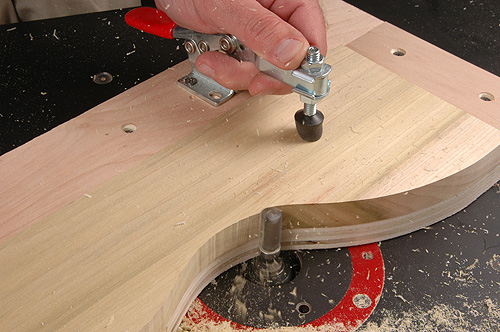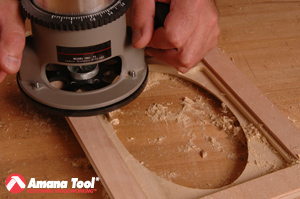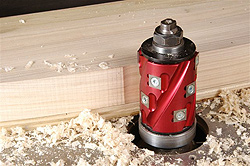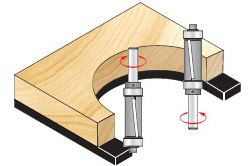I have painstakingly drawn up designs and planed a bunch of solid walnut for a small triangular shaped cabinet. The design calls for a cabinet with 60 degree mitered edges, and shelves made from joining three boards end to end on 60 degree angles. This should result in a triangular shaped cabinet with triangular shelves. Unfortunately, my table saw only adjusts to 45 degrees, and that's how I had intended to cut the 60 degree edges for the cabinet. And, my miter saw stops at 57 degrees, so I don't know how to cut the shelf boards. I found a 60 degree chamfer router bit form Amana (I couldn't find any other manufacturer that makes one), so that should let me cut the cabinet edges, but I still don't know how to make the shelves. Do miter saws typically adjust to 60 degrees? Is there a manual way to make these cuts precisely?
-Brian D.
Shalimar, FL
Triangular Cabinet
Our Expert
When making a corner cabinet I fit the interior with triangular shaped shelves. To insure that all of the shelves are identical and that they fit the cabinet precisely I use a technique called template routing.
To make the template I draw the shape of the triangular shelf full-size on 1/2" plywood. Next, I cut out the template on the bandsaw and follow the line carefully. Afterwards, I smooth the edges of the template by flush trimming with Amana Tool no.47101. I position a length of 1"x3" along the layout line and clamp it in place as a guide for the flush-trim bit.
To use the template I fasten it to the underside of the shelf stock with small brads. Be sure to locate the brads a few inches away from the edge of the stock. Although the small brad holes will not show on the finished
product you may prefer to use double-stick tape. I use cloth woodturner's tape because it has much greater holding power than ordinary carpet tape.
Before routing I trace the template onto the stock and bandsaw within 1/16" of the layout line. To shape the shelf I follow the edges of the template with the flush trim bit.



 Making a gooseneck molding for one highboy with a shaper cutter is very expensive. The gooseneck molding shaper cutters that I use are custom made and the cost is prohibit
Making a gooseneck molding for one highboy with a shaper cutter is very expensive. The gooseneck molding shaper cutters that I use are custom made and the cost is prohibit Routing with a guide template is one of the fastest and most accurate methods for creating multiple parts. As the guide bearing follows the template, the bit creates the shape
Routing with a guide template is one of the fastest and most accurate methods for creating multiple parts. As the guide bearing follows the template, the bit creates the shape  To cut a recess for glass you could use a
To cut a recess for glass you could use a 
 The bearing on a profile bit, such as Amana Tool
The bearing on a profile bit, such as Amana Tool 
